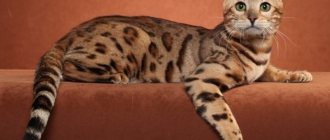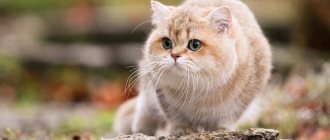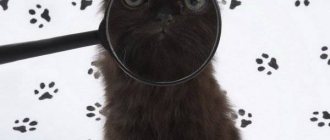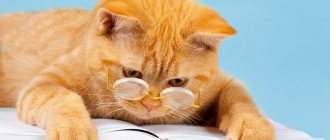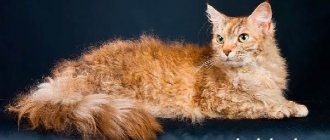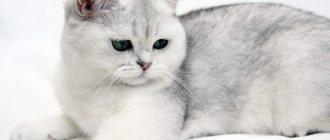The breed of exotic shorthair cats was developed in America in the second half of the 20th century . Cat lover and cattery owner Carolyn Basi crossed a Persian with a shorthaired Burmese to create a brown Persian cat. At the same time, several other nurseries crossed Persians with their short-haired counterparts to obtain a silvery coat. The kittens were born very similar to the Persian, but at the same time had short, thick hair .
Origin story
The path to officially breeding these hybrids was started by Jane Martink .
She insisted that the Association of Domestic Cat Breeders, as well as the CFA, recognize them as a new breed and allow them to perform at exhibitions. This happened in 1966. The breed was originally called sterling, which means silver of the highest standard . The cats were gray in color. But then they renamed it exotic, since the new color had not previously been seen in short-haired cats.
1967 was a year of success and victories for the new breed of cats. One of them won the status of champion . The highest award legitimized the existence of exotics officially.
In 1987, the CFA legalized the crossing of American Shorthair cats only with Persians. All other crossing options are considered illegal.
Sometimes an exotic cat's litter will include a long-haired kitten . This is due to a recessive gene that is responsible for long hair. These kittens were long considered a waste, but in 2010 they received the right to be considered a separate breed, an exotic longhair cat, although they were previously called the longhaired version of the shorthaired Persian cat.
Origin
Many people are interested: did the Cheshire cat breed once exist? And if not, who then is the prototype of the hero? There are several versions that historians have talked about:
- In England, the phrase “Cheshire cat smile” was once popular. It was used everywhere, and its meaning is an ironic, wide smile.
- Lewis Carroll was from the English county of Cheshire. In his homeland, lions were often depicted on the signs of various taverns. However, the artists did not see these animals in person, so each of them drew an image of a kitten.
- Another hypothesis also relates to Cheshire. It is small in size, but proud of its title. It was so funny, according to some, that even cats laughed at it.
- In the homeland of the author who gave the world the Cheshire feline, they were engaged in the production of wheels of cheese. The product was famous for its size. In appearance, it was a little similar to the faces of cats.
The Cheshire cat breed never existed in real life. However, each of the proposed hypotheses has a right to exist. And we are still unraveling the mystery of the origin of this character.
INTERESTING TO KNOW: Determining the weather by a cat
Description of the breed
Exotic shorthair cat of large or medium size .
She has short and thick legs and a muscular body. The large, round head is located on a thick neck. The eyes are round and large . There is a wide depression between the eyes, leading to a wide snub nose. The wide-set ears are small in size and have rounded tips.
The eyes, nose and forehead in profile are on the same straight line. The tail is thick and short. The body is proportional.
The weight of an exotic depends on gender . The cat should weigh 3.5 – 7 kg; cat – 3 – 5.5 kg. The texture of wool is soft and dense , reminiscent of plush to the touch. There must be an undercoat. Its length depends on the length of the coat. Exotics have different eye colors. Depends on the coat color of the animal.
The color of the shorthair is represented by 140 options . Let's list just a few of them:
- Red Tabby - This coat has a red tint. It is pronounced on the back line, and paler on the stomach.
- Marble - the shades can be any, but it must be a combination of 2 colors with marble lines.
- Blue
- Combination of gray and blue shades
- Black
- Tortoiseshell
- White
- Ginger
What breed was the Cheshire Cat?
In the famous fairy tale by Charles Perrault, there was a wonderful cat who caught rabbits and did a lot of interesting things that cats usually can’t do, in particular, he walked around in boots and spoke in a human voice. It was a Chartreux - a descendant of the large blue cats that lived at the Chartres monastery and guarded the famous wine cellars from rats. And Lewis Carroll, in his story “Alice in Wonderland,” wrote about a cat that can smile—Cheshire. Both tales are about the same breed, which is now called the British Shorthair. According to one version, the Chartreuse was brought to the British Isles by French sailors about 500 years ago; according to another, both had one more ancient ancestor. The historical chronicles of Ancient Rome mention large blue cats with sharp fangs and large round eyes, similar to copper bowls for sacrificial fire. The Romans took them with them on voyages to fight ship mice, and about 2,000 years ago, during the period of the Roman conquests, the first blue cat set foot on English soil.
British cats have long lived in aristocratic families and equally love everyone who lives nearby. However, the cute and clumsy “teddy bear”, seeing prey, turns into a tiger, and there is no escape from him for either a small mouse or a voracious rat, and a bird is unlikely to escape from him in a tree, where he “flies up” with a speed unthinkable for such a hulk. speed. The sailors, who suffered greatly from the lawlessness of rats in the holds, took the “British” with them on their voyages, and they lived up to their hopes. They say that this is why cats of this breed have short and strong legs, allowing them to stay on the deck during rocking. Towards the end of the 19th century, the British Shorthair was exhibited at the first famous cat show at London's Crystal Palace and immediately won universal love. Now this breed ranks first in popularity in European countries such as Holland, Belgium, Switzerland, and France.
“British” are the only ones in the cat world who have the ability to smile. Knowledgeable owners say that it is quite easy to make a cat smile - you just need to praise your pet well. You say: “You are young, handsome, cats love you,” and the shaved cheeks stretch into a condescending grin, and the copper-colored eyes look cheerfully at the owner. For many years, the most common color of the British Shorthair was its natural color - blue. Now there are “British” dogs, white and black, lilac and chocolate, red and cream, chinchilla, smoky, bicolor, colorpoint, merle... And this is not a complete list of their colors.
Photo: exotic shorthair cat
Character
These are very gentle, sweet creatures . They don’t raise their voices without a reason, but when they want something, they can be heard very well. Compared to their ancestors, the Persians, they are more energetic and love outdoor games. Exotics are very smart, not at all aggressive . They allow children to play with them, but only one family member is considered the owner. They hate loneliness and get along well with other animals in the house .
Important! Exotics are very vulnerable. Appreciate their love, caress and play with them more often. Cats get sick from lack of attention.
Care
The American Shorthair gave the exotics excellent health , but the Persians slightly corrected it, passing on their weak physical aspects.
These are watery eyes, snoring during sleep due to a flattened nose, and deformed teeth. Breeders of these animals say that these cats are for the lazy . They require virtually no maintenance. But some procedures will still have to be carried out daily or several times a month:
- Rinse eyes daily.
- Bathing . No more than once a quarter. During the molting period, 1-2 times a month.
- Trimming nails . Purchasing a claw point will make this task easier.
- Combing . You need to scratch your cat once a week. Exotic wool is prone to matting and requires regular careful grooming.
- It is necessary to dry the animal after bathing . The undercoat takes a long time to dry, and the animal may catch a cold.
- to remove worms from short-haired exotics regularly, once every three months.
Important! Proper feeding of the animal will ensure it has beautiful fur and no health problems. It is not recommended to feed exotics with human food.
That is, then no
The Cheshire Cat, whose photo you will find in the article, is famous not only for its smile, but also for its ability to disappear and appear at the most unexpected moment. According to historians, this ability appeared in the character due to the author's penchant for mysticism. Lewis Carroll was a famous fan of various legends, and he embodied one of them on the pages of his book. We are talking about the Congleton cat. We will tell you about this story next.
The abbess of Congleton Abbey had a favorite - a handsome cat. But one day this beloved furball did not return home. A few days later, the abbess heard a familiar scratching sound. Opening the door, the woman saw her cat, but after a few moments the pet seemed to melt into thin air. And for many years this ghost appeared and disappeared every evening before surprised spectators. This legend undoubtedly impressed Carroll, so the Cheshire Cat learned the same skill.
Health
We have already said that exotics inherited a tendency to disease from the Persians. To help a cat cope with the consequences of crossing, it is necessary to carry out a number of care procedures :
- Remove discharge from the corners of the eyes. If lacrimation is profuse, perform the procedure several times a day.
- Gingivitis is an inflammation of the oral tissues that leads to tooth loss. Consult your veterinarian and select a toothpaste for your cat. Use your own finger wrapped in gauze instead of brushes for cleaning. Preventive measures will relieve the animal of stone, plaque and toothache.
- After reaching the age of 5-6 years, many representatives of shorthaired exotics experience changes in kidney and liver tissue. These are harbingers of a serious illness. Polycystic kidney disease has no cure. But preventive measures can reduce the risk of disease and slow the progression of the disease.
- Another feature of exotics is a predisposition to heart disease. Most often, the tissue of the heart ventricle thickens. Cats get sick in adulthood. It is impossible to determine the disease by external signs.
Important! Owners of exotic animals do not need to worry that their pet will definitely inherit all these diseases. But you should be careful about your cat’s health, provide it with the necessary care and proper nutrition, then the risk of disease can be reduced to a minimum.
Kittens
Exotic shorthair kittens are very cute creatures. They adapt well to new conditions and quickly get used to their owners.
Newborn kittens look disheveled and awkward. As they grow, their fur becomes plush and their body takes on regular shapes . In a year they will look like adults.
All kittens are born with the same length of fur, but remember that there is a long-haired kitten in the litter. The tail will help determine which of them inherited the Persian's fur. In longhairs it has long hair and looks like a panicle . The tail of short-haired kittens at 4 weeks is covered with short, thick hair. At 1.5 months, the differences between short-haired and long-haired dogs become more noticeable.
Attention! Training to the toilet and sleeping place is not a problem, the kittens are quite smart.
The walk that gave the character
On July 4, 1862, Professor Charles Dodgson went on a picnic in the company of Robinson Duckworth, Henry Liddell and his three daughters. And none of them imagined the impact their little trip would have on world literature. Liddell's daughters had long known that Johnson could tell incredible stories, and this time they asked the professor to surprise them with a story. Charles could not refuse them and quickly came up with a fairy tale about a girl Alice, who went in search of adventure in a fantasy land.
Liddell's middle daughter, who, by the way, had the same name as the main character, liked this story so much that she asked Johnson to write it down for her. Charles took up the manuscript the very next day after the picnic, and in November 1864, the first version of Alice's adventures appeared, which he presented to his young fan.
Johnson was so moved by the story that he decided to publish it. To do this, the professor took the pseudonym Lewis Carroll, and in addition, he doubled the volume of the fairy tale and added a new character to it. This is how the Cheshire Cat appeared on the pages of a literary work.
But what prompted the author to come up with the idea of such a character? Next we will try to understand this issue.
